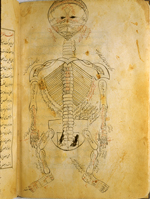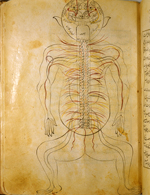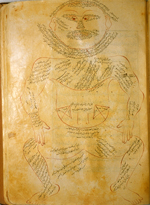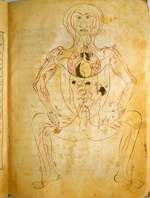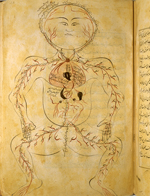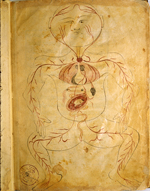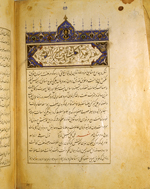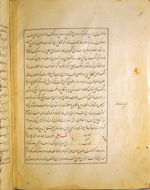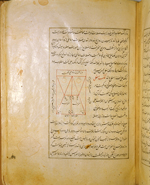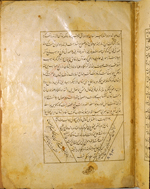Anatomy and Physiology
 Tashrīḥ-i badan-i insān (MS P 18)
Tashrīḥ-i badan-i insān (MS P 18)- (The Anatomy of the Human Body)
- تشريح بدن انسان
- by Manṣūr ibn Muḥammad ibn Aḥmad ibn Yūsuf Ibn Ilyās (fl. ca. 1390)
- منصور ابن محمد ابن احمد ابن يوسف ابن الياس
No anatomical illustrations of the entire human body are preserved from the Islamic world before those which accompany the Persian treatise composed by Manṣūr ibn Muḥammad ibn Aḥmad ibn Yūsuf ibn Ilyās, who came from a Persian family of scholars and physicians working in the city of Shiraz. His illustrated treatise, often called Manṣūr's Anatomy (Tashrīḥ-i Manṣūr-i), was dedicated to the sultan Ziyā’ al-Dīn Pir Muḥammad Bahadur, in all likelihood referring to Pir Muḥammad ibn ‘Umar ibn Timur, the ruler of the Persian province of Fars from 1394 to 1409 (797-811 H) and grandson of Timur, known to Europeans as Tamerlane.
The treatise consists of an introduction followed by five chapters on the five "systems" of the body: bones, nerves, muscles, veins, and arteries - each illustrated with a full-page diagram. The chapter on the skeleton was also illustrated with smaller diagrams of the cranial sutures and bones of the upper jaw with the positions of the teeth indicated. A concluding chapter on compound organs, such as the heart and brain, and on the formation of the foetus, was illustrated with a diagram showing a pregnant woman. The full-length illustrations (with the exception of the pregnant woman) have numerous labels in a mixture of Arabic and Persian. One of the two copies now at the National Library of Medicine is the earliest dated copy of Manṣūr ibn Ilyās's illustrated anatomy. It (MS P 18) was completed on 8 December 1488 (4 Muharram 894 H) by a scribe named Ḥasan ibn Aḥmad working in Isfahan. Whether the scribe also executed the illustrations as well as copying the accompanying text is unknown. The second copy at NLM (MS P 19) is undated and unsigned, but the nature of the paper, ink, and script suggests that it was executed in the late 15th or very early 16th century, also in Iran.
Most of the illustrations that Manṣūr ibn Ilyās used to illustrate his treatise were not original with him. The origin of the anatomical series of full-length figures remains a puzzle, but it clearly predates the Persian treatise by Manṣūr ibn Ilyās written at the end of the 14th century. Historians have noted the similarity between the first five full-length illustrations and certain early Latin sets of anatomical diagrams. This similarity is particularly evident in the diagram of the skeleton which in both the Latin and Persian versions is viewed from behind, with the head hyperextended so that the face looks upward and with the palms of the hands facing towards the observer - a posture, some have noted, suggestive of a dissection table. All the figures are in a distinctive squatting posture. The earliest Latin version dates from the 12th century, yet the earliest Islamic version is represented by the NLM manuscript produced in 1488. We do not know in what form, nor by what means, these full-length anatomical diagrams of the five systems were available to Manṣūr ibn Ilyās. The sixth figure in the series of full-page illustrations, the pregnant woman, was possibly a contribution by Ibn Ilyās himself, who was particularly concerned in his treatise with Aristotelian and Galenic embryological theories and their interaction with the tradition of Prophetic medicine. It was constructed from the arterial figure, with the labels removed and superimposed with an oval gravid uterus having the foetus in a breech or transverse position. The accompanying text of Manṣūr ibn Ilyās's treatise, however, gives no evidence for or against the suggestion that the sixth figure was his invention, for in the text itself the figure of a pregnant woman is never mentioned. The only reference in Manṣūr ibn Ilyās's treatise to an illustration occurs in the chapter on the nervous system, where it is mentioned that pairs of nerves are to be designated by certain colours. Nowhere else in the treatise does Manṣūr ibn Ilyās even mention illustrations accompanying his treatise.
The small schematic diagrams of cranial sutures and bones of the upper jaw (maxilla) that also illustrate the chapter on the skeleton by Manṣūr ibn Ilyās are to be found in Arabic medical encyclopaedias composed several centuries earlier. For example, copies of the Qānūn fī al-ṭibb (The Canon of Medicine) by Avicenna often have some of these diagrams in them; see MS A 53, fol. 11b detail, or MS A 62, fol. 60a for examples.
Over 70 sets of the Islamic full-page anatomical diagrams survive, of which about two-thirds are associated with copies of the treatise by Manṣūr ibn Ilyās. The remainder are more recent renderings, usually unlabelled, that circulated independently, with no accompanying text, or were inserted as illustrations into other treatises. For some of the preserved copies, see Storey PL II,2, pp. 225-7; Richter-Bernburg, "UCLA", pp. 46-53; Keshavarz, "Wellcome", pp. 340-2; and F.R. Maddison and E. Savage-Smith, Science, Tools, and Magic [Khalili Collection of Islamic Art, 12] (Oxford: Oxford University Press and London: Azimuth Editions, 1996), vol. 1, pp. 18-23. See also, the article "Eben Elyas" by Gül Russell in EncIr, vol. 8, pp. 16-20; and Andrew J. Newman, "Tashrih-i Manṣūri: Human anatomy between the Galenic and Prophetical Medical Traditions", pp. 253-271 in La science dans le monde iranien á l'époque islamique, ed. by Z. Vesel, H. Beikbaghban, and B. Thierry de Crussol des Espesse (Tehran: Institut Française de Recherche en Iran, 1998).
Tashrīḥ-i badan-i insān (MS P 18)
Illustrations
The skeleton, viewed from behind with the head hyperextended so that the mouth is at the top of the page. Copy completed by scribe Ḥasan ibn Aḥmad, working in Isfahan, on 8 December 1488 (4 Muharram 894 H).
The nervous system, with the figure drawn from the back and the nerves indicated in opaque watercolors. Copy completed by scribe Ḥasan ibn Aḥmad, working in Isfahan, on 8 December 1488 (4 Muharram 894 H).
The muscle figure, shown frontally, with extensive captions describing the muscles. Copy completed by scribe Ḥasan ibn Aḥmad, working in Isfahan, on 8 December 1488 (4 Muharram 894 H).
The venous system, with the figure drawn frontally and the internal organs indicated in opaque watercolors. Copy completed by scribe Ḥasan ibn Aḥmad, working in Isfahan, on 8 December 1488 (4 Muharram 894 H).
The arterial figure, shown frontally with the internal organs indicated in opaque watercolours. Copy completed by scribe Ḥasan ibn Aḥmad, working in Isfahan, on 8 December 1488 (4 Muharram 894 H).
The figure of a pregnant woman. This is essentially the arterial figure on which a gravid uterus with the foetus in a breech or transverse position has been superimposed. Copy completed by scribe Ḥasan ibn Aḥmad, working in Isfahan, on 8 December 1488 (4 Muharram 894 H).
Illuminated opening giving the title of the treatise in Arabic (hadha kitab Tashrih al-badan), drawn in ink and opaque watercolours. The style is typical of Timurid Workshops of scribes and illuminators.
A diagram of the cranial sutures, drawn in red and black ink.
A schematic inked diagram of the bones of the upper jaw (maxilla) with the positions of the teeth indicated.
The colophon, written diagonally at the bottom of the page. On the righthand side it states that the copy was completed on 4 Muharram 894 (= 8 December 1488), with the year written in both words and numerals. On the left side it says that it was copied by Ḥasan ibn Aḥmad, a scribe resident in Isfahan (katib-i muqim-i Isfahan) who was known as (al-mashhur bi-) Ardistani , that is, from Ardestan a town 65 miles northeast of Isfahan.
Physical Description
Persian. 39 folios. Dimensions 25.0 x 17.5 cm; text area 16.8 x 10.4 cm; 17 lines per page. The title is given in Arabic in the illuminated heading on folio 1b as hadha kitab Tashrih al-badan (This is the book The Anatomy of the Body). The author is named on fol. 2a line 8 as Manṣūr ibn Muḥammad ibn Aḥmad, though the words ibn Muḥammad were added later by the scribe as a marginal correction. The dedicatee is given on fol. 2a line 16 as Ziyā’ al-Dīn Amir-zadah Pir Muḥammad Bahadur.
The copy was completed on 4 Muharram 894 (= 8 December 1488), by Ḥasan ibn Aḥmad, a scribe resident in Isfahan (katib-i muqim-i Isfahan) who was known as (al-mashhur bi-) Ardistani , that is, from Ardestan a town 65 miles northeast of Isfahan (fol. 39a). The text is written in a careful and elegant nasta‘liq script within frames of two thin inked lines with the area between filled with gilt. Black ink with rubrications. There are catchwords and a few corrections written in the margin by the scribe.
The paper is thick, creamy, opaque and burnished with faint irregular laid lines and no visible chain lines. The paper is now much yellowed, and there is some water damage; the edges have been trimmed from their original size. Small inked diagrams occur on fol. 7b (cranial sutures) and 8a (bones of the upper jaw). Full-page illustrations, larger than the framed text areas of the other folios, occur on fols. 12b (skeleton), 18a (nerves), 20a (muscles), 25b (veins), 28a (arteries), and 39b (gravid uterus).
Binding
The volume is bound in a 14th-15th century Syro-Egyptian binding that is not original. The binding is too small for the volume. It is dark-brown leather over pasteboards with blind tooled mandorla medallions surrounded by thin tooled frames on each cover and on the envelope flap. The spine and edges have been repaired. The paper pastedowns have miscellaneous notes written on them, some obliterated. There are no endpapers.
Provenance
Fol. 1a is blank except for five owners' stamps, one of which is dated 1307 H [= 1889-90] and is repeated on fol. 39b near the foot of the pregnant woman; another of the stamps on fol. 1a is repeated under the colophon on fol. 39a. The volume was purchased in 1941 by the Army Medical Library from A. S. Yahuda who acquired it from a dealer in Teheran; it has an earlier catalogue label reading Med. ELS No. 1649 and a written notation of M 25.
References
Schullian/Sommer, Cat. of incun. & MSS., 1950, p. 335 entry P 18.
NLM Microfilm Reel: FILM 48-135 no. 1

